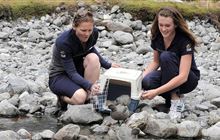
Introduction
We are the government agency charged with conserving New Zealand’s natural and historic heritage.How we manage New Zealand's natural and cultural heritage, legislation we work with, our history and corporate publications.
We work in partnership with iwi, community groups and businesses to achieve more conservation.
Our policies, plans and procedures describe how we manage the resources we are entrusted with.
Find out about our Minister, Director-General, senior leaders and business groups.
These statutory and advisory bodies report to the Minister of Conservation.
DOC cooperates with others from around the world to protect and restore natural and cultural heritage globally, in the Pacific and in Aotearoa.
View science publications by our staff and contractors. We publish several series, plans and reports.






